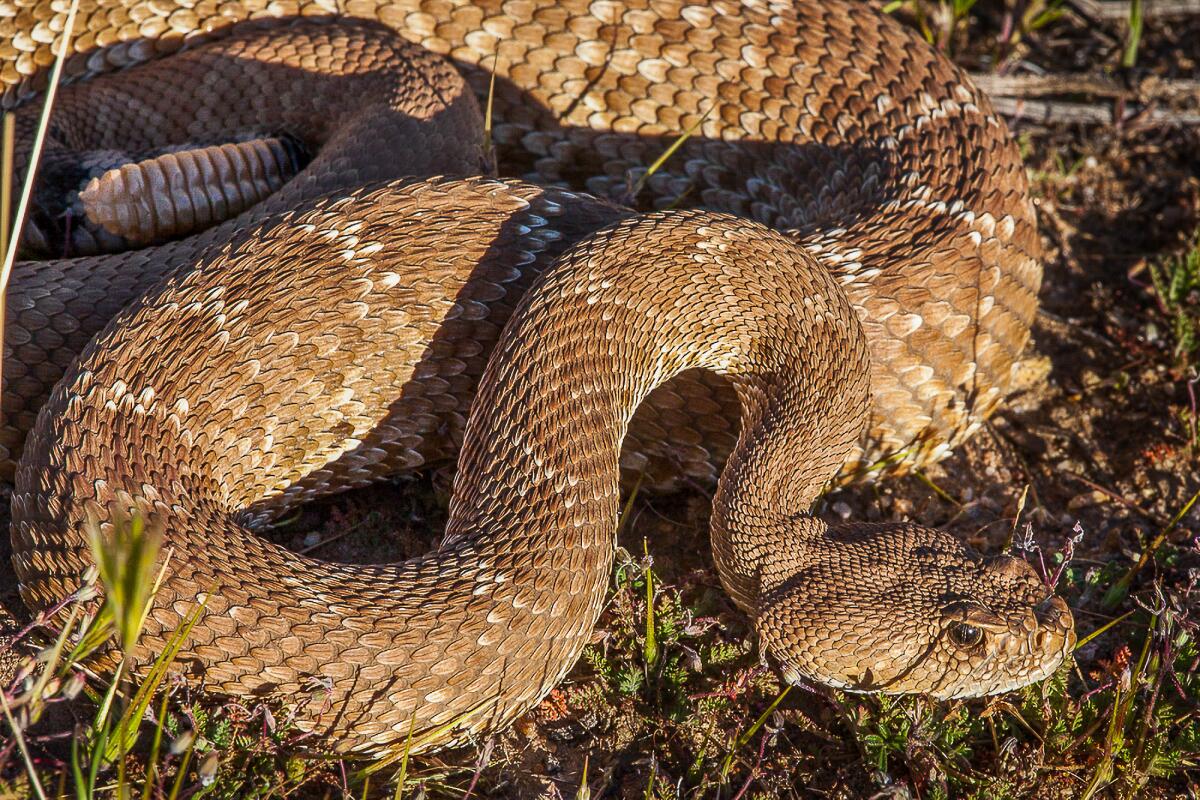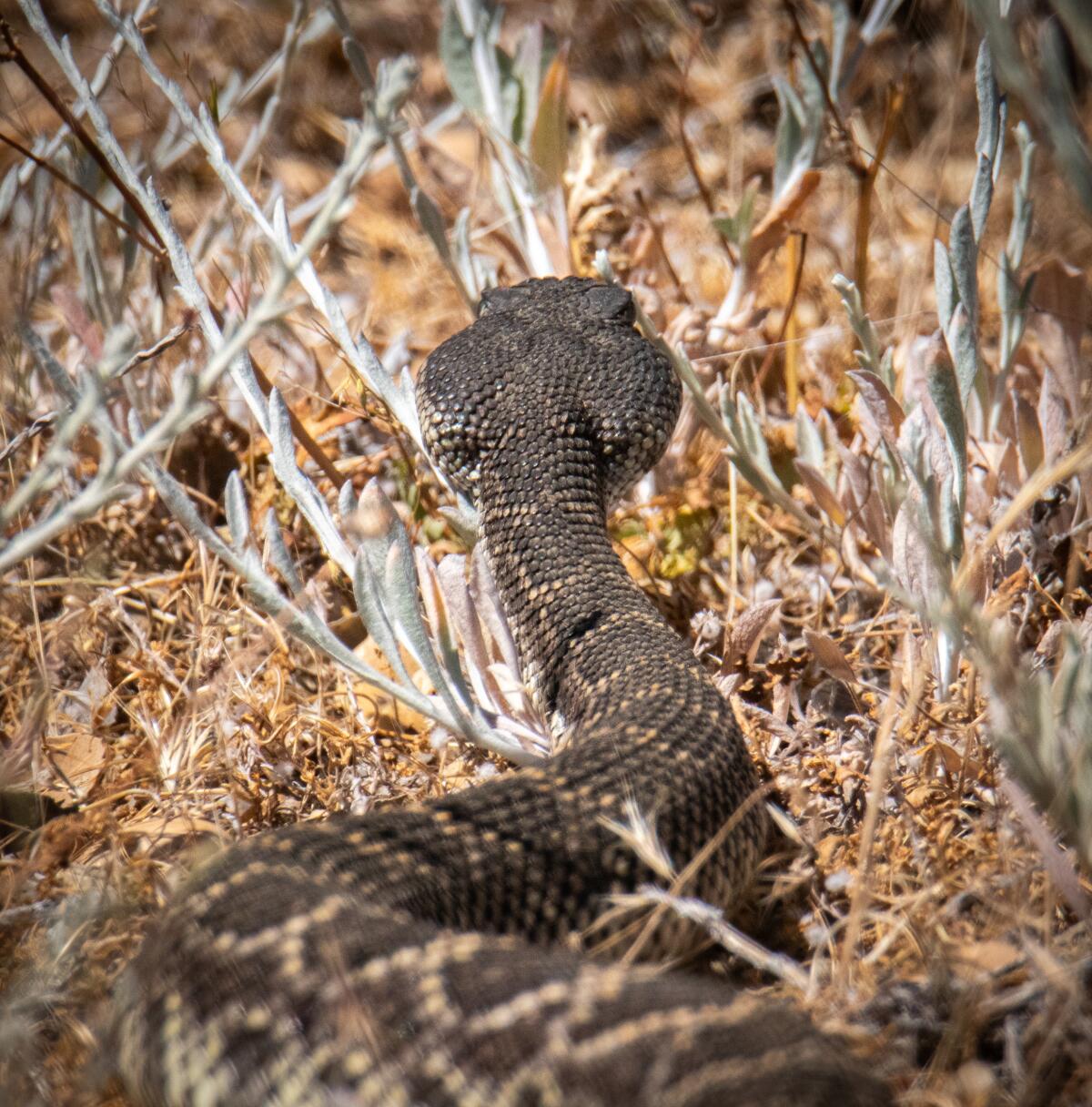Outdoors: What should you do if you’re bitten by a rattlesnake?

It’s important to learn protocol in case a rattlesnake bites you or your pet while out in the backcountry
I was leading a group of nature photographers on a desert wildflower trip and had warned them in advance to loudly shout “snake” if they happened to encounter one while tramping around in the brush.
It was an important safety alert.
“If you yell, ‘snake,’ it will let everyone know, so they can stay safely away,” I explained.
It sounded like such a great idea.
An hour or so into our trip, photographers were enjoying the beauty of a thick carpet of flowers, when someone shouted, “snake … oh, rattlesnake!”
I wasn’t worried; they had been warned to stay away.
I should have known better.
These were photographers, and instead of moving away, they were all surrounding a large, red diamond rattlesnake coiled defensively under a creosote bush.
It gave me shivers.
Fortunately, we were near vehicles and had cell service in case of a snakebite, but both snake and photographers escaped unharmed.
I often travel alone in the wilds, and any search-and-rescue professional will tell you that’s a recipe for disaster.
Sure, I’m well prepared, I let others know where I am, and I have lots of outdoor experience.
But as I stood recently in tall spring grass with a rattlesnake loudly buzzing nearby, I realized I really don’t know what to do in case of a snakebite.
Maybe a better way of saying it would be, “I don’t know the RIGHT thing to do.”
I have years of training, but things change, and perhaps it was time to upgrade my rattlesnake first-aid knowledge to the latest version.
As a kid, we carried little red rubber kits with antiseptic, suction cups and razor blades to cut open the bite and suck out the venom.
It seemed like such a brave thing to do.
Later, first-aid protocol evolved into simply tying on a tourniquet and rushing the bite victim to a hospital.
Often these treatments were more damaging than the bite.
Thankfully, things have gotten simpler.

I turned to some experts for the latest advice on dealing with a rattlesnake bite for you or your pets.
Lt. Rob Sills, leader of the San Diego County Sheriff’s Search and Rescue Medical Unit, said team members are trained to follow a few simple rules if bitten, or if encountering a person who has been bitten.
Immediately call 911. Remove constrictive clothing, watches and rings before swelling begins. If swelling or redness is obvious, mark the boundary and note the time.
Keep subjects calm, immobilize the bitten area and keep it at or below the heart. As soon as possible, seek emergency medical care.
Lee Cantrell, managing director of the San Diego division, California Poison Control system, provided some additional insight.
While venomous snake bites are painful, death is rare with treatment, with only about 10 per year nationally out of about 8,000 bites. San Diego County recorded 44 rattlesnake bites in 2023, according to Cantrell.
“The key is getting bite victims to the hospital as quickly as possible,” Cantrell said.
Hospitals with emergency rooms are all equipped with antivenom.
Cantrell said there are two types of antivenom, and both are effective for any kind of rattlesnake bites.
“Don’t waste time trying to identify or capture the snake. We’ve had people bitten several times trying to catch the snake,” Cantrell said.
Worries about snake encounters should not keep people from enjoying the backcountry. In fact, most bites happen around the home.
A few years ago, I was waiting for my wife at the front door and glanced down to see a large rattlesnake coiled in a flowerpot. Stay alert at home.
Pets are more frequent victims of snakebite.
Veterinarian Chamkaur Brar at the Country Pet Hospital in Alpine said he has already seen two patients this spring as temperatures warm up and snakes become active.
Typically, May sees the most animal bites because temperatures are ideal for snake activity, and lots of new brush and grass provide places for snakes to hide.
Brar treats an average 30 rattlesnake bites per year, with most happening around the home.
He urges pet owners to keep areas around their homes cleared of weeds, tall grass and brush.
He said owners will know when a pet has been bitten, because it’s extremely painful for the animal.
Like humans, medical care for pets should be sought quickly.
“Every veterinarian, especially in our rural areas has antivenom,” Brar said. “With treatment, most pets will survive. I’ve only lost 10 since I began in 1994.”
A few simple precautions can significantly reduce your chances of an unpleasant snake encounter.
While unnerving, the buzzing sound of a rattlesnake is designed to warn you. Pay attention and move away. Snakes will not attack or chase you. You are not their prey.
If you step on a rattlesnake, reach into a hidden area, or are trying to handle one, you may be bitten defensively.
I’ve had dozens of rattlesnake encounters over the years and have learned a few things.
Off trail, I wear knee-high snake boots in case I startle or step on one while moving through tall grass or brush.
If I do hear a buzzing rattler, I stop, determine where it is and simply move away.
I don’t kill rattlesnakes; they are an import part of nature’s rodent-control system.
Enjoy the outdoors, just use a little caution, and know what to do in case of a bite.
Cowan is a freelance columnist. Email ernie@packtrain.com or visit erniesoutdoors.blogspot.com.
Get Essential San Diego, weekday mornings
Get top headlines from the Union-Tribune in your inbox weekday mornings, including top news, local, sports, business, entertainment and opinion.
You may occasionally receive promotional content from the San Diego Union-Tribune.









